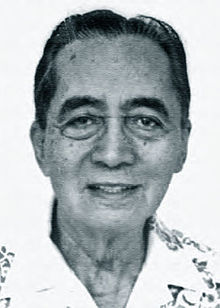Francisco Soc Rodrigo
| Francisco "Soc" Rodrigo | |
|---|---|
 |
|
| Senator of the Philippines | |
|
In office December 30, 1955 – December 30, 1967 |
|
| Personal details | |
| Born |
Francisco Aldana Rodrigo January 29, 1914 Bulacan, Bulacan, Philippine Islands |
| Died | January 4, 1998 (aged 83) Quezon City, Philippines |
| Political party | Liberal Party |
| Occupation | Politician |
Francisco "Soc" Aldana Rodrigo (January 29, 1914 – January 4, 1998) was a Filipino playwright, lawyer, broadcaster, and a Senator of the Third Congress (1955–1957), Fourth Congress (1958–1961), Fifth Congress (1962–1965), and Sixth Congress (1966–1969) of the Republic of the Philippines.
Soc Rodrigo was born on 29 January 1914 in Bulacan, Bulacan, to food vendor Marcela Aldana and horse-carriage driver Melecio Rodrigo. He was a relative to the Filipino heroes Marcelo del Pilar and Gregorio del Pilar.
Rodrigo finished elementary at Bulacan Elementary School and secondary school at the University of the Philippines High School. He earned his Bachelor of Arts and Bachelor of Science in Education degrees from Ateneo de Manila and University of Santo Tomas, graduating magna cum laude and valedictorian. He was captain of the debate team at university.
In 1937, Rodrigo married his childhood sweetheart Remedios Enriquez. Prior to this, he took Law at the University of the Philippines, which he finished in 1938.
Rodrigo was a playwright in English and Tagalog, with works described as those that distilled within the Filipino soul. His most celebrated play was Sa Pula, Sa Puti while his most popular Kuro – Kuro sa likod ng mga Balita had also won legions of admirers throughout the country. Some other famous works include Tagalog translations of works of Martyr of Golgotha and Cyrano de Bergerac. Rodrigo was also known for his tanaga.
During the Japanese occupation of the Philippines in World War II, Rodrigo distributed anti-Japanese propaganda materials together with Raul Manglapus and Manuel Fruto. In his book "Mga Bakas ng Kahapon", Rodrigo reflected on the fate he and his family of four may have suffered had he been implicated by Manglapus and Fruto during their capture. In 1945, he moved his family to the underground basement of the Philippine General Hospital in Manila, where they survived the building’s destruction.
...
Wikipedia
